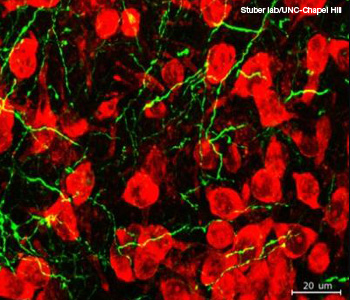Scatterings
Controlling Animal Behavior with Light
Scientists used optogenetics—a combination of genetic engineering and laser technology—to study the pathways between two parts of the brain involved in feeling reward.
 Recent optogenetics research targets the connections between the nucleus accumbens (red) and amygdala fibers (green).
Recent optogenetics research targets the connections between the nucleus accumbens (red) and amygdala fibers (green).
By using low-power laser pulses, researchers at the University of North Carolina at Chapel Hill demonstrated that they could manipulate the brain wiring responsible for reward-seeking behaviors in mice. They used optogenetics—a combination of genetic engineering and laser technology—to study the pathways between two parts of the brain involved in feeling reward, the amygdala and nucleus accumbens (Nature 475, 377, 2011; doi:10.1038/nature10194).
…Log in or become a member to view the full text of this article.
This article may be available for purchase via the search at Optica Publishing Group.
Optica Members get the full text of Optics & Photonics News, plus a variety of other member benefits.

